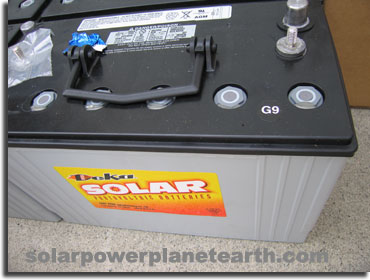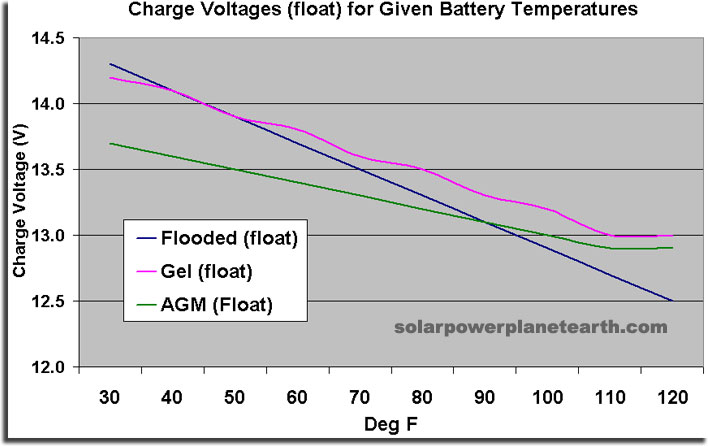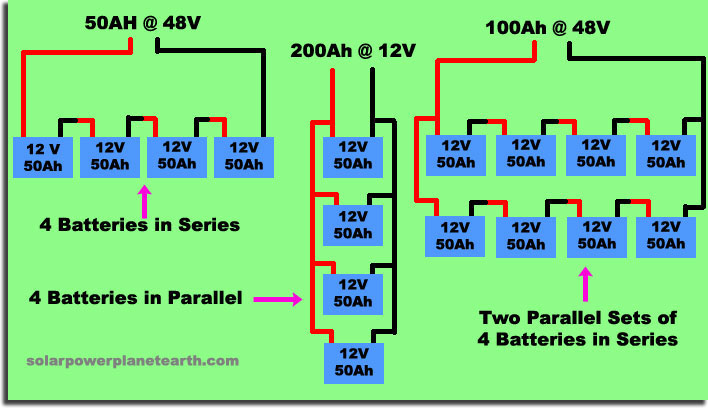 |
Solar System Batteries
As with charge controllers, batteries are only required with off-grid solar systems, or hybrid solar systems. They are not used with grid-tied systems since these systems utilize the utility grid as a giant battery. Batteries used in renewable energy systems have to have a few important characteristics in order to be practical. The most important of these characteristics is the ability to "deep cycle" many times without loosing the ability to hold a charge. Deep cycle batteries are also known as "deep discharge" batteries. Since most renewable energy systems utilize lead-acid batteries, they shall be the main topic of this page.
A battery converts stored chemical energy into electrical energy when being used, and vice versa when being charged.
So What is a Deep Cycle Battery?
A deep cycle battery has the ability to be discharged to a very low level, typically upwards of 80% depletion, and then fully re-charged, over and over again. This is in contrast to a starting battery, like you have in your car, which is made to provide a large amount of instant current, but not be discharged more than 5%. A starting battery can typically be deeply discharged less than a hundred times, sometimes much less, before it will no longer hold a charge. Each time it is deeply discharged, its life span is reduced dramatically. A starting battery will last thousands of cycles if NOT deeply discharged.
A deep cycle battery can not provide the same amount of instantaneous current as a starting battery. This starting current is not needed in a typical renewable energy setup. The two main differences (ability to deep cycle and amount of instantaneous current) are mainly due to the size and style of the lead plates that make up the battery cells. The more surface area that each plate has, the more instant starting current it can provide, and the fewer number of times it can be deep cycled. A deep cycle battery will typically have solid plates compared to a starting battery having sponge-like plates to increase surface area.
Amp-Hour (Ah) Capacity of a Battery
A starting battery is typically rated by "cranking amps," which simply refer to the amount of instantaneous current they can provide, as described above. A deep cycle battery's capacity is rated in Amp-Hours (Ah). Amp-Hours translates to the number of amps that can be delivered for an hour. It can also be translated a few different ways, that are better explained using the following examples.
So lets say we have a 12V 100Ah battery. This means that this battery can provide 100 Amps (A) for 1 hour at 12V. It also means it could provide 1A for 100 hours at 12V. So depending on your load, your battery will last for a given number of hours. This math can be applied to various loads to determine your battery bank size. Your solar contractor will do the math for you, but if your interested, see the bottom of the page for details on making this calculation. In the real world, you don't want to deplete your battery 100%, for the reasons mentioned above. A good general rule of thumb is to size your battery array so that under worst case conditions you never deplete more than 60% of your battery's capacity.
How Much Charge Does My Battery Have Left?
To truly measure remaining capacity, you need to perform a specific gravity measurement, however, a close second is to simply look at the voltage level of the battery. It is important that when reading a batteries voltage level, that it is not done during or right after it has been charged, otherwise it will be relatively meaningless due to effects such as surface charge. The following table represents the voltage levels of various size battery banks, at different charge levels, based on a temperature of 25C (77F). When a 12V battery reaches 10.5V, it is typically considered fully discharged. The table assumes a nominal open circuit 2V cell voltage of 2.12V.
| Charge | 12V Battery Bank (V) | 24V Battery Bank (V) | 36V Battery Bank (V) | 48V Battery Bank (V) | Zone |
|---|---|---|---|---|---|
| 100% | 12.70 | 25.40 | 38.10 | 50.80 | This is the zone recommended for maximum battery life |
| 90% | 12.50 | 25.00 | 37.50 | 50.00 | |
| 80% | 12.40 | 24.80 | 37.20 | 49.60 | |
| 70% | 12.30 | 24.60 | 36.90 | 49.20 | |
| 60% | 12.20 | 24.40 | 36.60 | 48.80 | Entering this zone occasionally is acceptable, but not recommended. Battery life will be reduced. |
| 50% | 12.05 | 24.10 | 36.15 | 48.20 | |
| 40% | 11.90 | 23.80 | 35.70 | 47.60 | |
| 30% | 11.75 | 23.50 | 35.25 | 47.00 | |
| 20% | 11.55 | 23.10 | 34.65 | 46.20 | Battery life will be reduced drastically if this zone is entered and should be avoided unless extreme circumstances call for it. |
| 10% | 11.30 | 22.60 | 33.90 | 45.20 | |
| <10% | <10.50 | 21.00 | 31.50 | 42.00 |
It is important to note that once the battery ages, the amount of charge that the battery can hold will be reduced. This means the battery may still charge to the above mentioned voltage levels, however, will deplete much faster. Note that each of the above voltages are in an open circuit condition, meaning there is no load drawing current from the battery at the time the voltage reading is taken.
Main Types of Lead-Acid Deep Cycle Batteries
Flooded Batteries
Flooded batteries are also known as "wet cells." The main advantage of flooded batteries is that they are the most economical when it comes to cost. However, they are on the opposite end of the scale when it comes to maintenance, self discharge, charge/discharge efficiency, and safety. They require occasional replenishing of the electrolyte, self discharge about 10% faster than AGM or Gelled SLA batteries, have a 10% lower charge/discharge efficiency, and require a well ventilated space for the hydrogen and oxygen they vent during charging and equalization.
Valve Regulated "Sealed" Lead Acid Batteries (VRLA)
VRLA batteries are "sealed," meaning there is no potential of spilling the acidic contents, and no having to refill the electrolyte. SLA batteries can be mounted in any position since there is no danger of spilling the contents. The design of a VRLA battery allows recombination of the hydrogen and oxygen, to eliminate (minimize) out gassing when overcharged. If a battery is overcharged to a high voltage, the "valve" allows any excess hydrogen to vent. Even though venting is very limited for VRLA batteries, when it does occur, it reduces the amount of useful contents inside the battery, thus reducing its overall capacity. There are two main types of VRLA batteries, which are discussed below.
1) Gelled VRLA
Gelled batteries have their sulfuric acid mixed with silica fume, which combines to make a gel-like texture. Gelled batteries are more expensive than flooded batteries, however, have all the advantages of a VRLA battery. The biggest disadvantage of gelled batteries is that they require a slower charge rate, which makes them non-ideal for certain applications where rapid charging is needed or used. This fact also makes them more vulnerable to damage and premature failure from overcharging, care must go into choosing the correct charger. Gelled batteries have the best utility in very deep cycle applications.
2) Absorbed Glass Matt (AGM) VRLA
Instead of mixing the electrolyte with silica to create a gel, AGM batteries have the electrolyte absorbed into a mat of fine glass fibers. AGM batteries have the lowest self-discharge rate of all the batteries mentioned above, and outperform gelled batteries at colder temperatures. They have the lowest internal resistance and can also be charged/discharged at a much faster rate. The biggest disadvantage is the price of an AGM battery compared to a flooded battery. Each end user must decide which parameters are more important before choosing a battery type for his/her renewable energy system.
Battery Life span
There are many variables that affect battery life span, however, they can all be related to the proper care and maintenance of the battery. Battery life span is usually specified by the number of times it can be cycled before it will no longer hold a charge. The two most important factors are proper charging and depth of discharge. Most charge controllers will regulate the charge cycle of a battery, however, some have more advanced features which help to prolong battery life, such as three stage charging (bulk, absorption, and float), temperature compensation (see paragraph below), and battery type specification. By being able to specify the type of battery (flooded, Gel, AGM) the charging voltage is adjusted for that type of battery to prevent overcharging and premature battery failure. Your battery bank should be kept in a room temperature environment, as excessive heat will drastically reduce battery life. If taken care of, Gelled batteries can last 2-5 years, and AGMs about 4-7 years.
Temperature Compensation During Charging
As it should be clear by now, batteries are affected by temperature, charge voltage being no exception. A batteries charge voltage must be adjusted according to the ambient temperature to prevent over/under charging. Charge controllers that have this temperature compensation ability typically come with thermocouples that are easily attached to the battery terminals. From the chart below, you can see how charge voltage is typically adjusted for different battery types and temperatures.

Charge Rates
Battery charge rates differ based upon battery technology and design. Each battery type has a physical limit on how fast it can absorb a charge. Pushing more charge current into a battery faster than it can handle it, will cause excessive out gassing, which not only posses a safety hazard, but can permanently damage most batteries. The battery type most susceptible to this is the Gelled battery. Depleted pockets can be formed within the gel, causing permanent loss in battery capacity. Once again, care must be taken in choosing a charge controller which can adjust its charging levels accordingly. AGM batteries don't have this charge rate limitation (to a certain extent) and can be charged very rapidly compared to a gel battery.
How to Size Your Battery Bank
So how big should my battery bank be? There are two main considerations. Load size/duration, and physical space. Large amp-hour capacity batteries are heavy and take up space, so naturally you must take this into consideration when choosing how big of a battery bank you can fit in your well ventilated space.
Assuming you have the physical space, the calculations for load size/duration are the same regardless of which type of solar system you have, off-grid, or grid-tied with battery backup. In your calculation, you must consider how much power each device (light, refrigerator, television, etc.) will draw when on, and how long (duration) each device will operate every day. Keeping in mind that we don't want to drain our batteries down to less than 70% of their rated capacity to prolong their life, this shall also be taken into consideration when sizing our battery bank. Here are the steps for sizing a battery bank with three electrical devices (for simplicity, but can be followed for as many devices as needed):
1) Continuous power draw (in watts) of device one, times the number of hours of operation per day.
2) Continuous power draw (in watts) of device two, times the number of hours of operation per day.
3) Continuous power draw (in watts) of device three, times the number of hours of operation per day.
4) Add up the total number of watt-hours needed per day.
5) To not get below 70% battery capacity (30% drain), divide the number you got in line 4 by 0.3.
6) Take the number you got in line 5 and divide it by the voltage size of your battery bank to get amp-hours needed.
An example shall now be shown using the above steps. In this example, ten 15W compact florescent lights, a refrigerator that draws an average of 500kWh/year, and a television that uses 100W shall be used. The lights shall be needed for 7 hours/day, the refrigerator 24hours/day, and the television shall be used 5 hours/day. We are going to arrange our battery bank into a 48V configuration. Following the above steps:
1) 15W x 10 lights x 7 hours = 1,050Wh/day
2) Refrigerator uses 500kWh/year, divide this by 365days/year = 1,370Wh/day on average
3) 100W x 5 hours = 500Wh/day
4) 1,050Wh/day + 1,370Wh/day + 500Wh/day = 2,920Wh/day
5) 2,920Wh/day / 0.3 = 9,733Wh/day
6) 9,733Wh/48V = 203Ah
So your battery bank needs to have a 101Ah capacity in a 48V configuration. That's it! Keep in mind these numbers are conservative since your solar system will provide all needed power to your loads during the day once the batteries are fully charged, so in reality, the batteries only have to power your loads for a portion of the day, but it is always a good practice to calculate your battery bank size based on worse case conditions so that your loads will never be without power. Remember, the capacity you need changes if you change the voltage level of your battery bank!
How to Arrange the Batteries to Achieve the Desired Capacity and Voltage Levels
Depending on if you wire up your batteries in a series, parallel, or series-parallel combination, will determine the overall capacity and voltage level of your battery bank. Here are the general rules for wiring batteries:
We can combine these two types of configurations to achieve any capacity and voltage (as long as it is a multiple of an individual battery's voltage and/or capacity). The following graphic visually explains these relationships and shows how you can manipulate the voltage and capacity levels of your battery bank:

A good solar contractor will do all these calculations for you!